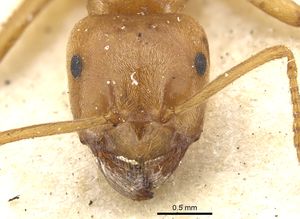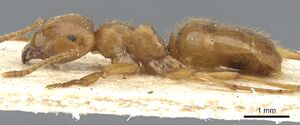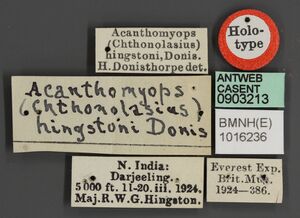Lasius crinitus
| Lasius crinitus | |
|---|---|

| |
| Scientific classification | |
| Kingdom: | Animalia |
| Phylum: | Arthropoda |
| Class: | Insecta |
| Order: | Hymenoptera |
| Family: | Formicidae |
| Subfamily: | Formicinae |
| Tribe: | Lasiini |
| Genus: | Lasius |
| Species: | L. crinitus |
| Binomial name | |
| Lasius crinitus (Smith, F., 1858) | |
| Synonyms | |
| |
Identification
Keys including this Species
- Key to Lasius Palaearctic workers
- Key to Lasius males
- Key to Lasius queens
- Key to the Lasius of the Indian Himalayas
Distribution
Known only from the Himalayas.
Distribution based on Regional Taxon Lists
Oriental Region: India (type locality), Nepal.
Distribution based on AntMaps
Distribution based on AntWeb specimens
Check data from AntWeb
Countries Occupied
| Number of countries occupied by this species based on AntWiki Regional Taxon Lists. In general, fewer countries occupied indicates a narrower range, while more countries indicates a more widespread species. |

|
Estimated Abundance
| Relative abundance based on number of AntMaps records per species (this species within the purple bar). Fewer records (to the left) indicates a less abundant/encountered species while more records (to the right) indicates more abundant/encountered species. |

|
Biology
Castes
Images from AntWeb
   
| |
| Holotype of Acanthomyops hingstoni. Worker. Specimen code casent0903213. Photographer Will Ericson, uploaded by California Academy of Sciences. | Owned by NHMUK, London, UK. |
Nomenclature
The following information is derived from Barry Bolton's Online Catalogue of the Ants of the World.
- crinitus. Formica crinita Smith, F. 1858b: 13 (q.) INDIA. Wilson, 1955a: 188 (w.). Combination in Lasius: Mayr, 1862: 700; in L. (Chthonolasius): Emery, 1925b: 233. Senior synonym of hingstoni: Wilson, 1955a: 187. See also: Bingham, 1903: 339; Collingwood, 1982: 293.
- hingstoni. Acanthomyops (Chthonolasius) hingstoni Donisthorpe, 1929a: 448 (w.) INDIA. Junior synonym of crinitus: Wilson, 1955a: 187.
Unless otherwise noted the text for the remainder of this section is reported from the publication that includes the original description.
Description
Worker
Wilson (1955) - On the basis of its size, pilosity, petiole shape, and geographic origin, Donisthorpe's species hingstoni is considered herein the worker caste of crinitus. Three of Donisthorpe's syntypes were used in the following diagnosis.
(1) Exceptionally large; PW 0.88, 0.90, and 0.93 mm. respectively.
(2) Dorsal crest of petiole seen in frontal view wedge-shaped, its sides tapering upward to form an angular, non-emarginate median prominence.
(3) Body pilosity consisting of long, coarse, suberect-erect hairs; maximum length on first two gastric tergites 0.18 mm., on pronotum 0.21 mm., on occiput 0.23 mm. These hairs are concentrated mainly on the occipital margin, pronotum, posterior third of the mesonotum, dorsal convexity of the propodeum, dorsal crest of the petiole, and entire gastric surface; they are occasional over the anterior surface of the head. Appendages completely lacking outstanding pilosity except for a few short, erect hairs on the coxae.
(4) Scapes somewhat flattened, maximum width at midlength 0.13 mm., minimum width 0.08 mm.
(5) Contrary to Donisthorpe's statement, the maxillary palps are not five-jointed, but six-jointed as in other species of Lasius.
Queen
Wilson (1955) - (1) Largest Lasius known; HW of Sikkim queen 1.99 mm.
(2) Pilosity of alitrunk and gaster consisting of extremely long, fine, sinuous, predominantly appressed yellow hairs, which are concentrated along the posterior margin of the pronotum, lateral faces of the scutum, lateral and ventral sides of the first two gastric segments, frontal declivity of the first gastric tergite, and whole surfaces of the exposed posterior gastric segments. They are especially abundant on the posterior gastric segments, converging to form a matted sheath over the apex, but they are sparse over most of-the dorsal surfaces of the first two gastric segments and the scutum, and absent altogether from the appendages, the head, most of the pronotum, and all of the propodeum. Similar hairs, many doubled over and wicket-shaped, form a dense fringe along the dorsal crest of the petiole. Shorter, mostly non-sinuous hairs occur on the mandibles and around the metapleural gland openings. The single specimen examined (Sikkim) is rather badly battered and probably has had some hairs worn off, but its pilosity pattern still agrees generally with that described by Bingham for the holotype.
(3) Scape moderately flattened; in the Sikkim specimen, maximum width at midlength 0.15 mm., minimum width 0.12 mm.
(4) Gastric tergites with abundant appressed pubescence.
(5) Body uniformly ochraceous, the appendages somewhat lighter. The entire body, including the gastric tergites, shagreened and feebly shining to subopaque.
(6) Petiole in frontal view with broadly rounded dorsolateral corners, converging toward the midline to meet a narrow, obtusely angular median excision.
Type Material
Wilson (1955) - HOLOTYPE. A queen in the British Museum.
References
- Bingham, C. T. 1903. The fauna of British India, including Ceylon and Burma. Hymenoptera, Vol. II. Ants and Cuckoo-wasps. London: Taylor and Francis, 506 pp. (page 339, see also)
- Collingwood, C. A. 1982. Himalayan ants of the genus Lasius (Hymenoptera: Formicidae). Syst. Entomol. 7: 283-296 (page 293, see also)
- Dendup, K.C., Dorji, C., Dhadwal, T., Bharti, H., Pfeiffer, M. 2021. A preliminary checklist of ants from Bhutan. Asian Myrmecology 14, e014005 (doi:10.20362/am.014005).
- Emery, C. 1925d. Hymenoptera. Fam. Formicidae. Subfam. Formicinae. Genera Insectorum 183: 1-302 (page 233, Combination in L. (Chthonolasius))
- Mayr, G. 1862. Myrmecologische Studien. Verh. K-K. Zool.-Bot. Ges. Wien 12: 649-776 (page 700, Combination in Lasius)
- Seifert, B. 2023. A revision of the Palaearctic species of the ant genus Cardiocondyla Emery 1869 (Hymenoptera: Formicidae). Zootaxa 5274(1), 1–64 (doi:10.11646/zootaxa.5274.1.1).
- Smith, F. 1858b. Catalogue of hymenopterous insects in the collection of the British Museum. Part VI. Formicidae. London: British Museum, 216 pp. (page 13, queen described)
- Subedi, I.P., Budha, P.B., Bharti, H., Alonso, L. 2020. An updated checklist of Nepalese ants (Hymenoptera, Formicidae). ZooKeys 1006, 99–136 (doi:10.3897/zookeys.1006.58808).
- Wilson, E. O. 1955a. A monographic revision of the ant genus Lasius. Bulletin of the Museum of Comparative Zoology 113: 1-201 (page 188, worker described; page 187, Senior synonym of hingstoni)
References based on Global Ant Biodiversity Informatics
- Collingwood C. A. 1982. Himalayan ants of the genus Lasius (Hymenoptera: Formicidae). Systematic Entomology 7: 283-296.
- Collingwood C.A. 1970. Formicidae (Hymenopter: Aculeata) of Nepal. Himalaya Khumbu Himal, 3: 371-388.
- Donisthorpe H. 1929. The Formicidae (Hymenoptera) taken by Major R. W. G. Hingston, M.C., I.M.S. (ret.), on the Mount Everest Expedition, 1924. Annals and Magazine of Natural History (10)4: 444-449.
- Thapa V. K. 2000. An Inventory of Nepal's Insects, Vol. III. IUCN Nepal, Kathmandu, xi + 475 pp.

